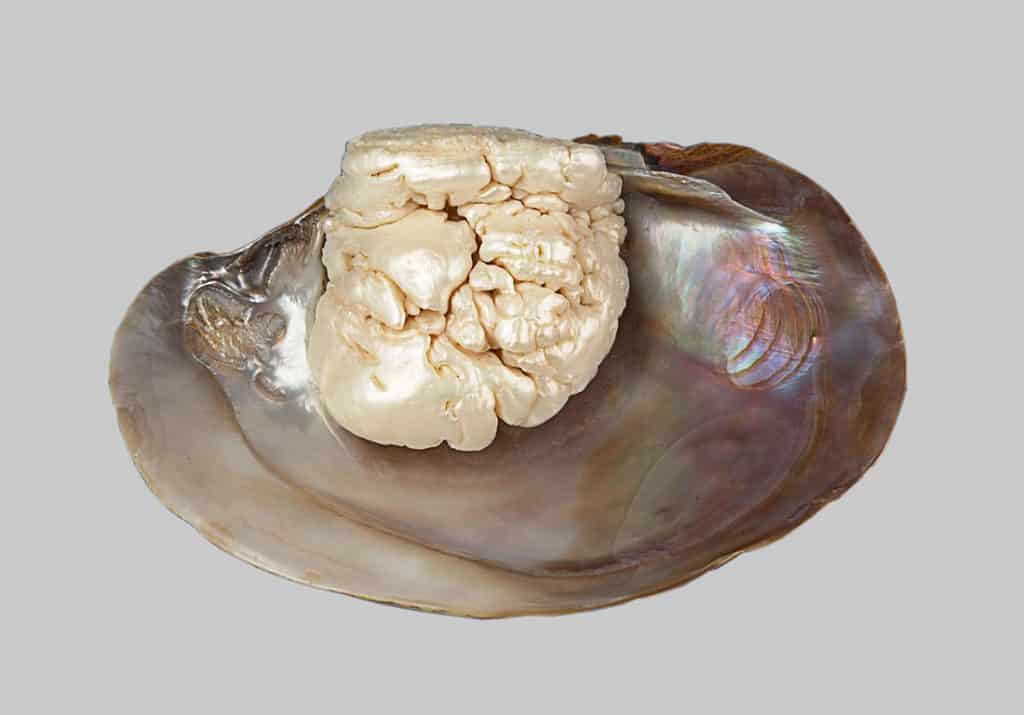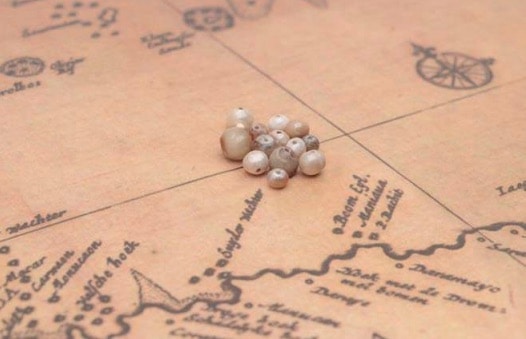
The historic ‘Sleeping Lion Pearl’, a natural Blister and not a Pearl

by Dr. M.S. Krzemnicki, first published in Facette 23 (February 2017)
Recently, the Swiss Gemmological Institute SSEF had the opportunity to investigate an impressive natural nacreous formation with documented provenance dating back to the late 18th century, named the ‘Sleeping Lion Pearl’ due to its baroque shape that is reminiscent of a lion (Figure 1).
Originating from a freshwater mollusc, this historic ‘pearl’ was first documented 1778 as being sold in Amsterdam (Netherlands). Just a year later, it was sold again in St. Petersburg (Russia), and from there went through several hands throughout Europe until it was finally sold in Italy to the Dutch goldsmith Lodewijk Willem van Kooten who brought it back to Amsterdam in 1868, where it stayed in private hands until present. A detailed description of the historical provenance of the ‘Sleeping Lion Pearl’ can be found in Zwaan & Dommisse (2009) and Zwaan et al. 2014 (both in the Journal of Gemmology).
Having read about the ‘Sleeping Lion Pearl’ in gemmological literature, we were very impressed by the size and weight of the item when we received it earlier this year (approximately 69.90 x 44.00 x 38.00 mm and weighing 593.25 ct). The colour was light cream with subtle rosé, purple and green overtones. Such overtones are due to an iridescence effect on the nacreous surface and greatly contribute to its beauty.
What followed was a meticulous study, which revealed that the nacreous formation historically known as the ‘Sleeping Lion Pearl’ in fact represents a natural blister that formed in a freshwater mollusc, and is neither a pearl nor a blister pearl. This conclusion is based on careful visual observations, and mainly relies on a detailed three dimensional analysis of its internal structures using X-ray microtomography (Yxlon Cougar at SSEF). It showed no onion-like spherical ring structures in the nacreous formation typical for pearls or blister pearls, but only curved layers of nacre (Figure 2) deposited on each other in a ‘mushroom’-like structure indicating proliferating (pathological) nacre accumulation on the shell forming this enormous blister.

Figure 2: A microtomographical section (XZ orientation) along the growth direction of the described blister reveals no onion-like ring structures (as expected for a pearl or blister pearl), but only curved and accumulated (stacked) layers of nacre, characteristic for a natural blister formation. Figure: M.S. Krzemnicki & J. Braun, SSEF
How to define blister, blister pearl and pearl?
In principle, any mollusc producing a hard shell and living in freshwater or marine waters may form a calcareous concretion by a process known as biomineralisation. In historic times, all these natural products were commonly called ‘pearls’, although since then three main categories have been defined (see also CIBJO Pearl Book), based on differences in their formation and appearance.
Natural pearls form in a pearl sac within the mantle tissue of the mollusc due to an irritation of the mantle tissue and are made of ± spherical rings of calcium carbonate (e.g. nacre). They are not attached to the shell.
Natural blister pearls start to form as a pearl, but eventually their pearl sac disintegrates partially, with the result that the mantle tissue on the inner side of the shell starts to cover this pearl with nacreous layers. It is now attached to the shell and called a blister pearl. A cross section through a blister pearl will reveal concentric (spherical) rings of calcium carbonate (e.g. nacre) in the inner part, wrapped by subsequently formed layers of calcium carbonate (e.g. nacre) which are continuous with those of the inner side of the shell (see CIBJO pearl book) and thus attach the blister pearl to its shell. To be used in jewellery, blister pearls have to be cut from the shell. As a consequence, they are commonly polished/worked at the base. In some cases, a blister pearl may also fall off the shell quite easily when the shell is harvested.
Natural blisters are nacreous formations bulging on the inner surface of a shell. They form spontaneously due to an irritation of the mantle tissue of a mollusc or by the intrusion of foreign bodies on the inside of a shell. A cross section through a nacreous blister will reveal curved and more or less half-domed layers of nacre inside, optionally with hollow cavities but no onion-like ring structures as in pearls or blister pearls.
Blisters are part of the shell and as such always have to be cut from the shell. As a consequence, they are polished/worked at the base. Blisters are more common than pearls or blister pearls. If they are large, they are generally understood as being the product of proliferating growth of the mantle tissue, thus they commonly reveal a baroque shape with deep surface indentations and rippled outline and then often very much dominate the shell in which they form (see Figure 3).
Based on our findings, we conclude that this exceptional item – historically known as the ‘Sleeping Lion Pearl’ – is in fact the result of such proliferating nacre accumulation on the shell and thus represents a natural blister. It has to be noted that at the time it was named, any nacreous formation from within a shell was called a pearl, as the modern concept to distinguish pearls from blister pearls and blisters was not yet known.




